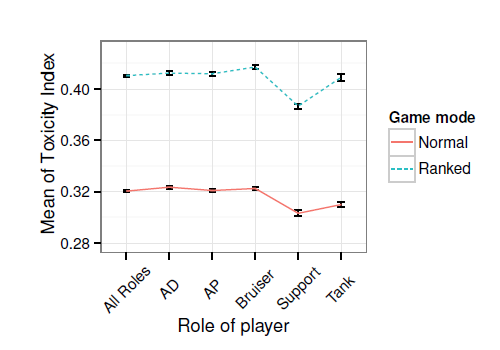转载:Deviant behavior in League of Legends: Do jerks drive off other players?
一篇关于LOL的数据分析 http://grouplens.org/deviant-behavior-in-league-of-legends/
Deviant behavior in League of Legends: Do jerks drive off other players?
January 11, 2014
This post describes work appearing at CSCW 2014.
Many online activities today involve interacting with other people, and these interactions are often dictated by social norms – unspoken rules that classify socially acceptable behavior. Whether intentional or otherwise, people sometimes break these rules. Behavior that goes against established norms is called deviant behavior, and in many cases is assumed to be negative. In online communities, deviant behavior is commonly believed to be harmful, and is expected to drive users to leave the community. For example, intentionally incorrect responses on a question and answer site may discourage new users from asking questions. Our work looks at patterns of player behavior in an online game. We build a metric to predict a specific kind of deviant behavior, toxicity, and we use this metric to examine whether deviant behavior causes other players to quit
违反基准社会行为标准的“毒瘤行为”是否会导致用户从社会团体中流失。老鼠屎和粥的故事
We look at deviant behavior in the popular online game League of Legends. League of Legends is a competitive multiplayer game where two teams of five players compete to destroy the other team’s base. Each player controls a single character, and every character has unique abilities which, when used skillfully, can help the player’s team overcome an enemy team. If you’ve never played League of Legends, check out this four-minute introduction video from League’s developer, Riot Games.
Deviant behavior in League of Legends is a known problem. Riot has addressed it with several interventions, such as rallying the community behind a common code of conduct and using social psychology techniques to subtly influence player behavior. Problematic deviant behaviors in League of Legends manifest in several ways: A player could verbally abuse other players, quit a match early or help the enemy team win. Riot is specifically concerned with some of these behaviors, which they call “toxicity.” In their talk last Spring, they define toxicity as any behavior that negatively impacts other players’ experiences. You can see more on Riot’s efforts to influence player behavior in their GDC2013 talk.
Using data donated by Duowan (the creators of a popular Chinese add-on for League of Legends) we analyzed 18 million matches across three months. The add-on allows players to give feedback to their teammates. From recorded social and match data, we built a metric called toxicity index. Toxicity index is a ratio between “thumbs up” and “thumbs down” scores, used to identify players with consistently negative feedback. A higher toxicity index means a player was given lots of negative feedback by their peers. Similar to the “report a player” feature built in to League of Legends, thumbs down messages are strongly associated with toxic behavior in the game.
Toxicity Index
Once we were able to identify toxic players, we found several common correlations with toxicity index:
- Ranked matches are more competitive matches which have a public-facing rating. Players in ranked matches often had a higher toxicity index than players in normal matches. 排位赛比普通匹配中更容易出现低分评价、负面评价和恶意行为
- Different character roles predicted different levels of toxicity. 不同英雄角色的负面评价不同
- Playing characters with lots of damage-dealing abilities (carries and bruisers) usually predicted players with higher toxicity indexes. Carry位和中单通常负面评价较高
-
Different character roles predicted different levels of toxicity.
-
Playing characters with lots of damage-dealing abilities (carries and bruisers) usually predicted players with higher toxicity indexes. Carry和中单通常负面评价较高
-
Playing characters with abilities that promote teamwork (supports and tanks) usually predicted players with lower toxicity indexes. 辅助和tank通常负面评价较高
-
 Average player toxicity index by role and game mode,with standard error bars.
Average player toxicity index by role and game mode,with standard error bars.
- While we expected more positive feedback, players teaming up with friends received more negative feedback from their non-friend teammates. 通常组队的常被单排的打低分

What predicts quitting?
We also wanted to look for factors that drove players to quit the game. To do this we separated players by tenure, splitting experienced and inexperienced players. Using a regression, we examined player retention in terms of both finishing their current gaming session and quitting the game for a long time (or for good).
- Newer player’s session length didn’t seem to be affected by playing with toxic teammates, regardless of their own toxicity index.新玩家的游戏时间貌似不会被他们的毒瘤队友影响
- Newer players were less likely to quit for a long period when they had a high toxicity index, and were more likely to quit for a while after playing with toxic teammates. 新玩家不会因为自己的毒瘤而暂停自己的游戏行为(意思虽然毒瘤但是自己乐在其中),但是如果碰到了毒瘤玩家,游戏结束后,新玩家会暂停一段时间(意思被别人的毒瘤影响了体验)
- Surprisingly, experienced players were more likely to continue their session when they were toxic, or when some of their teammates were toxic. However, if the player and their teammates both had high toxicity indexes, the player was likely to end their session. 令人惊奇的是,老玩家不管是自己毒瘤了还是队友毒瘤了,都会继续玩下去。但是如果自己和队友都毒瘤了,那么就会结束游戏不再继续玩下一把
-
Both experienced and new players who play with friends are more likely to play another match. 不管新老玩家都喜欢跟朋友一起玩
-
Playing with friends also kept newer players from taking a long break from the game, and playing with friends was the only factor that kept experienced players from quitting for good. 与朋友一起玩是保持游戏粘性的终极法宝
In summary, we found different game modes, character abilities and playing with friends all correlated with different levels of toxic behavior. Additionally, newer players who were toxic were less likely to quit the game, and newer players who weren’t toxic were likely to quit after encountering toxic teammates. Playing with friends predicted players at all levels would keep playing.
总结:
1. 正义菜鸟玻璃易受伤,邪恶菜鸟以破坏为乐趣(真是符合社会心理学)
2. 社交,人-人互动才是终极法宝
Want to learn more? Read our full paper, accepted to be published this February at CSCW 2014.



